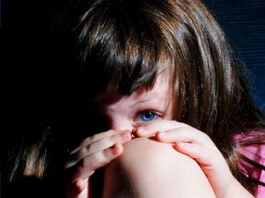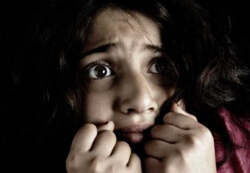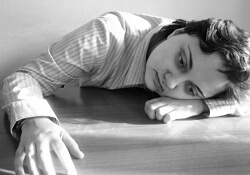Schizophrenia in children
 Schizophrenia in children and adolescents is a mental illness that affects the brain systems, affecting the cognitive( cognitive) as well as the emotional sphere. As one of the most common mental illnesses, schizophrenia affects up to 1% of all people.
Schizophrenia in children and adolescents is a mental illness that affects the brain systems, affecting the cognitive( cognitive) as well as the emotional sphere. As one of the most common mental illnesses, schizophrenia affects up to 1% of all people.
The manifestations of schizophrenia in children and adolescents are numerous. These include hallucinations, delusions in thinking, loss of will, emotional stupor to various violations of the adequate functioning of the brain. Children and teenagers are disturbed by voices, visions that are not perceived by loved ones, or by others. Previously, childhood psychiatric schizophrenia included various psychotic disorders, as well as children diagnosed with autism
Signs of schizophrenia in children
How does schizophrenia manifest in children? When the disease occurs, children are turned off from normal, as well as from collective life. Schizophrenia affects first of all the very personality, attitude towards people, to the whole surrounding life. Personal disturbances come to the fore. Children change interests, behavior, ideals. At the time of an attack the personality of the ill person loses unity, and also loses his connection with the world. The tragedy of the majority of students suffering from schizophrenia is manifested much earlier before the manifestations of the disease.
The first signs of schizophrenia are expressed by the difficulties associated with teaching. If a child with schizophrenia starts to learn badly and has restless thoughts about the future, then this is probably the first signs of the disease. The child becomes contactless, gloomy, it seems to him that he is worse than others and therefore to him a bad attitude.
Ill go away from the team, closing in solitude, as if nothing interests him, and everything around him is unpleasant. Interests are manifested in what was pleasing before.
Children with schizophrenia seem to have no inner life, no center, no aspirations. Loss of vital energy, increasing autism, detachment from the whole world, coldness to all - this all leads the child to a gradual disintegration of the personality.
A sign of schizophrenia in children is a perception disorder, consisting in the inability to combine perceived elements into a single image. As one of the signs of schizophrenia, there are difficulties in isolating the essential elements of objects. It manifests itself in a stuck on details, inability to embrace the whole, not by the ability to separate the essential from the nonessential. About their experiences they say: life, as in a dream. Children are difficult to distinguish dreams from reality, they are visited by bright and very bizarre thoughts, and ideas. The behavior of children is peculiar and has an extreme sophistication, there are problems in creating a circle of friends.
The behavior of children varies over time, and schizophrenic psychosis builds up gradually. Children begin talking about strange ideas and fears, cling to parents or say things that do not make sense at all. Accustomed to enjoying relationships with a certain circle, become shy with others, while living in their own world.
Children with schizophrenia in the acute phase face difficulties in understanding the meaning in front of colorful paintings. They are not able to understand the emotional experiences of the actors depicted in the picture. It follows that the perception of sick children with schizophrenia is marked by fragmentation, the image is perceived unilaterally, subjectively, often by chance.
When sluggish schizophrenia is noted understanding what is happening in pictures and in life. Children are able to give an adequate description of the pictures.
The next sign of schizophrenia in children is the rapidly changing activity of attention due to the rapid loss of interest in any activity. During the experiments, it was confirmed that attention in the acute schizophrenia phase functions for a short time. As soon as the enhanced stimulation ceases, then immediately a stop occurs in the task, and attention becomes a wandering character.
When immersed in painful experiences, it is difficult for sick children to concentrate on memorizing educational material, as emotional, verbal-logical, motor, imaginative memory suffers.
Children with schizophrenia suffer from the fact that unpleasant facts are kept in memory. Obsessions often bring a lot of trouble to children. They are concerned that they repeat the same actions( rituals)
all the time. Schizophrenia in children - symptoms
How to recognize schizophrenia in a child? And what are the peculiarities of schizophrenia in children?
Symptoms varied and diverse:
- appearance neologisms, word formation( e.g., cellar - burial; kladovaya- cemetery);
- delayed speech, stuttering, voice muffled, sometimes it fast or jerky, laconic;
- a violation of thinking;
- the simultaneous emergence of thoughts, with each series of thoughts able to exist separately;
- the fading of thoughts in conversation;
- the inability to drive away thoughts, because of their abundance;
- ambivalence( contradictory) judgments;
- lack of a unified line of understanding, approach to the problem from different positions;
- uncertainty about what they say, and also do;
- difficulties when necessary to answer questions;
- difficulties in generalization;
- the severity and incoherence of thinking;
- introduction without the meaning of words;
- learning difficulties, distractions, experiences about failures in school;
- diffuse reading;
- indecisiveness, uncertainty;
- verbosity, the desire for refinement of formulations;
- temporary loss of understanding words;
- incompleteness of thought;
- defect of purposefulness, rupture of associations;
- reduction of intellectual activity;
- emotional devastation, lack of interests and inactivity;
- violation of higher intellectual processes, impoverishment of the psyche, weakening of its flexibility;
- repetition of thoughts, automatism of thinking;
- lack of emotional contact and loss of feelings of sympathy, indifference, lack of joy;
- a mix of feelings of joy and sadness, experiences about failures in school;
- lack of emotional contact and loss of feelings of sympathy, indifference, lack of joy;
- the appearance of rudeness, tactless acts;
- great egocentrism, self-love, lack of attachment to relatives;
- mixing the feelings of joy and sadness,
- love for a distant and at the same time an aversion to a close;
- interest in general issues, but not to current issues;
- the vision in my life is only bad, but good only in Western Europe;
- negativism, counteracting what is required by adults;
- weakening of the will and unwillingness to live, to do anything;
- distrust of yourself, slowness, aimlessness;
- focusing only on a short time interval.
In the presence of the patient's eidetic ability, an arrangement to fixing the visual material arises. For example, after seeing the deceased, the image of this person will remain in memory for a long time. The obsession is so unpleasant to the child that it worsens his condition.
A big role is assigned to representations at the moment of experiencing the reality of the world around them. Children with schizophrenia seem to be around, like in a dream, and the surrounding life is a fairy tale. For children, geometry is difficult to study, it is difficult for them to represent projections, but algebra is given easier.
Creative imagination, imagination occupies the main place in the activity of preschool children. They are subject to the ease of reincarnation, the creation of illusory participants in the game.
School-age children are losing the tendency to fantasize, and the presence of this feature in older preschoolers says the delay at an early stage of development. Excessive pathological fantasizing characteristic for children with unstable mentality when animates inanimate objects. Children preschoolers pathologically fantasize and at the same time get on with the characters of their fantasies. They live a stereotyped life of the game, and it in turn is diametrically opposed to the surrounding reality.children try to realize the aspirations unrealizable in reality, dreams of power and the opening of new countries, very creative, interested in questions of a philosophical nature
schizophrenia forms in
children are the following forms of patients with schizophrenia: catatonic, disorganized or youthful, simple form, grafted form.
Catatonic form is characterized reticence, catatonic stupor in passing excitation, solidifies in poses negativism, refusal of food, as well as voice contact. Depression and detachment from the surrounding reality is noted in sick children with a catatonic form. This form of schizophrenia is characterized by both long-term remission and complete recovery.
The gebefrenic( youthful) form is characterized by a slow flow characteristic of the senior school age. The disease begins suddenly: acute headache, absent-mindedness, insomnia. The main symptom of the disease is unmotivated foolishness, delusions, hallucinations. Disease outcome in favor dementia
simple form of schizophrenia
Characteristic for all age groups, the distinguishing feature acts loss of interest, emotional indifference, increasing lethargy, isolation and reduced intelligence.
Episodic disturbance of hallucinations, as well as paranoid state with malicious aggression. Patients wander the streets. The disease is progressing, leads to dementia apathetic and grafted impoverishment psyche
schizophrenia form
Characteristic for children who have had organic brain damage, and as a result of delayed mental development, mainly mental retardation.
The child is whimsical, closed, irritable. The course and outcome of the disease may result in a recovery, as well as a prolonged remission.
The clinic distinguishes such forms as continuously current, paroxysmal-progredient, recurrent-periodic.
But the researchers adhere to the VM classification. Bashina, which includes continuous, malignant, maloprogredientnaya, paroxysmal paroxysmal maloprogredientnaya, paroxysmal recurrent and sluggish schizophrenia
diagnosis of schizophrenia in children
To date, there is an open question at issue relating to the diagnosis of childhood schizophrenia. Schizophrenia in adolescents manifests five times more often than in preschool children. Interestingly, some of the children have been sick since childhood, but have not been diagnosed on time.
Diagnosis of schizophrenia in children occurs when a doctor contacts a sick person. According to the results of the conversation, the doctor builds a picture of the clinic of the disease, which is further confirmed by tests and tests. If the child has personality disorders, apathy and impoverishment of emotions, plus distracted attention, poor memory and concentration - the doctor immediately diagnoses the disease. Then the brain functions, as well as the nervous system, are to be studied, and a small patient is recommended to be examined for other diseases.
tests, research, brain imaging, electroencephalography show a clear picture of the disease and the doctor prescribe treatment
Schizophrenia in children - treatment
Early diagnosis for the treatment of schizophrenia is very important. Psychiatric treatment is recommended for many symptoms and problems of schizophrenia, and parents should insist upon this after visiting a therapist so as not to miss the onset of the disease.
Schizophrenia in children and adolescents successfully treated with individuality and the involvement of other professionals. A combination of drugs is important, as well as individual, family therapy and the introduction of specialized programs.
Treatment of schizophrenia in children, as well as adolescents, includes atypical antipsychotics. They are good in that they have fewer side effects, unlike standard drugs.
More articles on the topic:
• Schizophrenia in men • Schizophrenia in women



